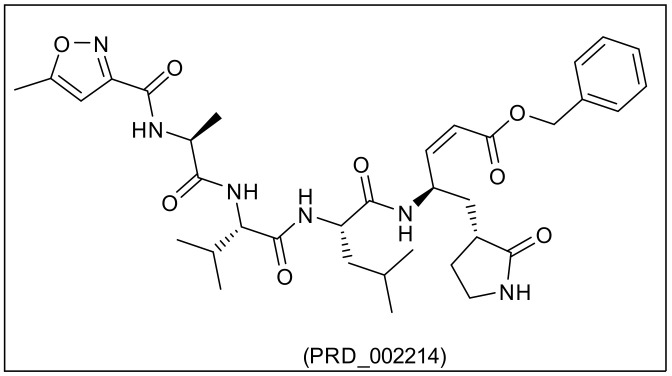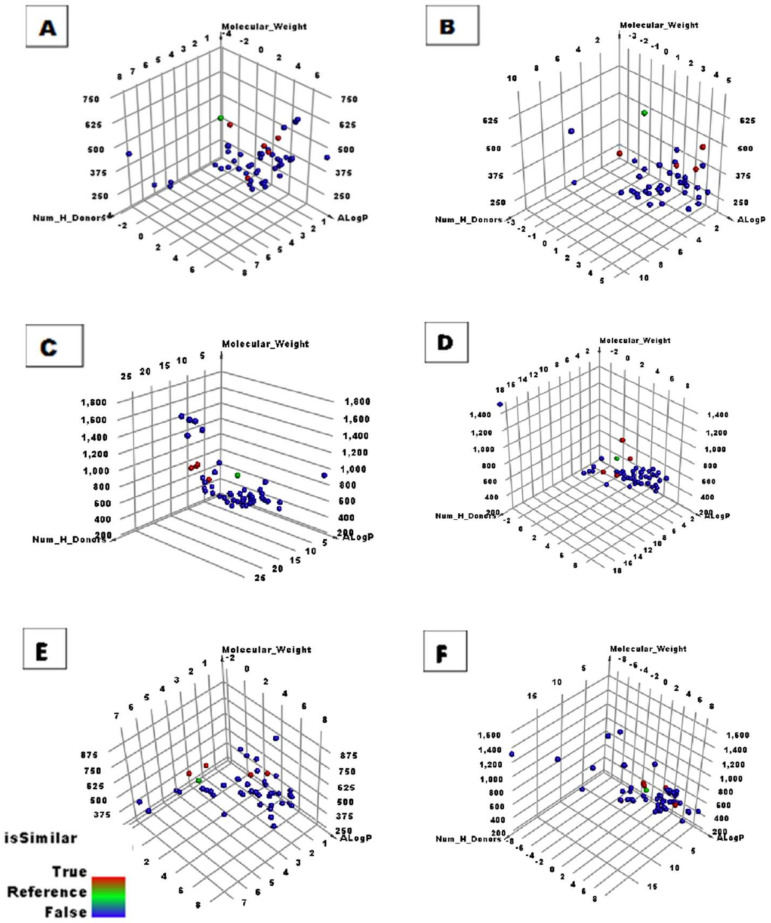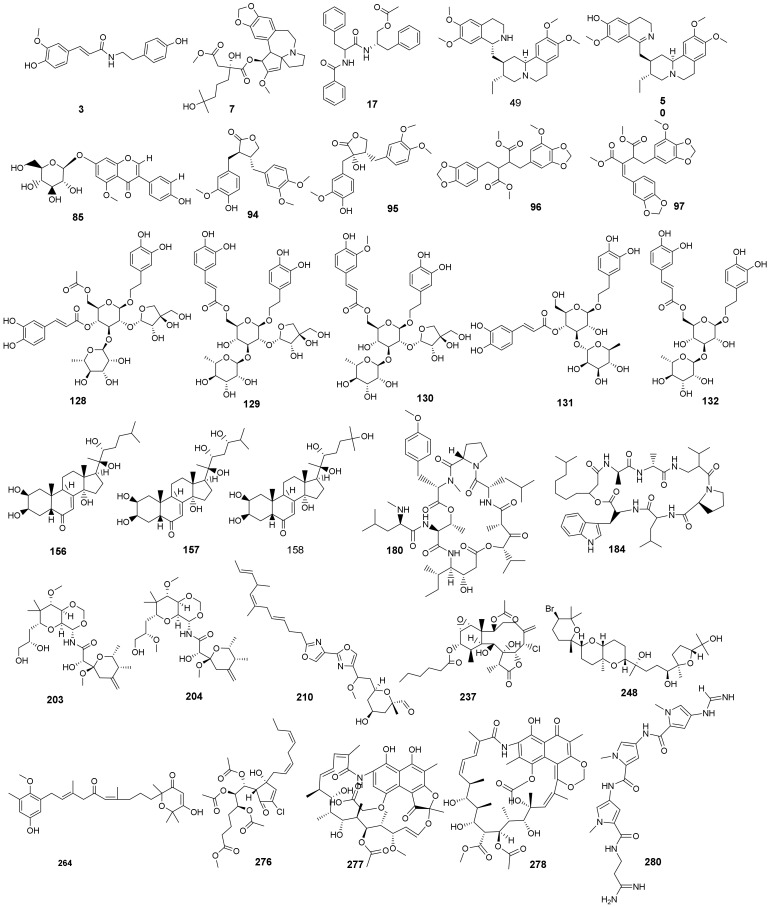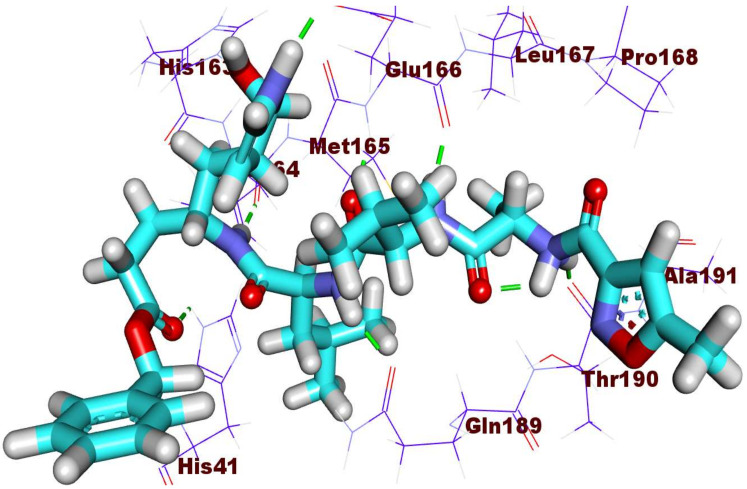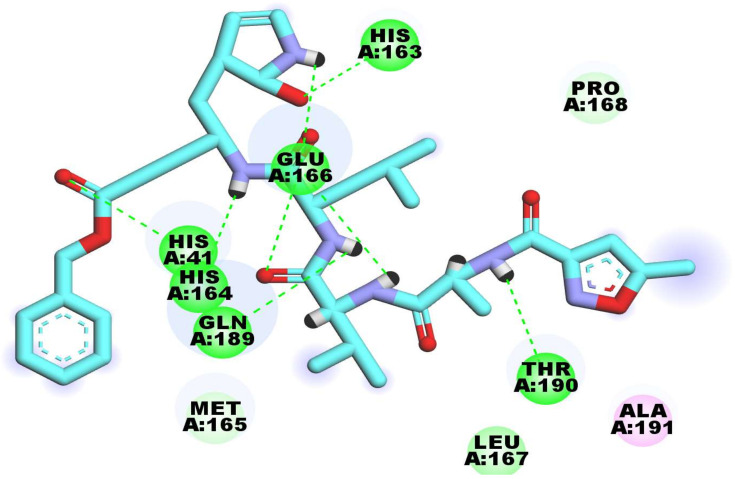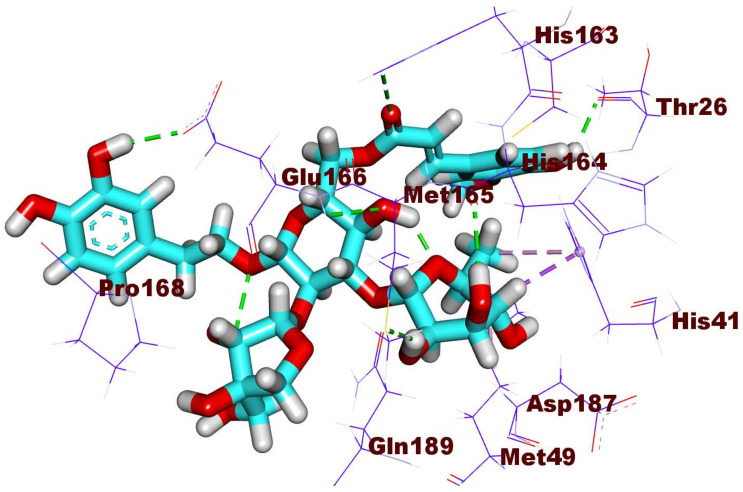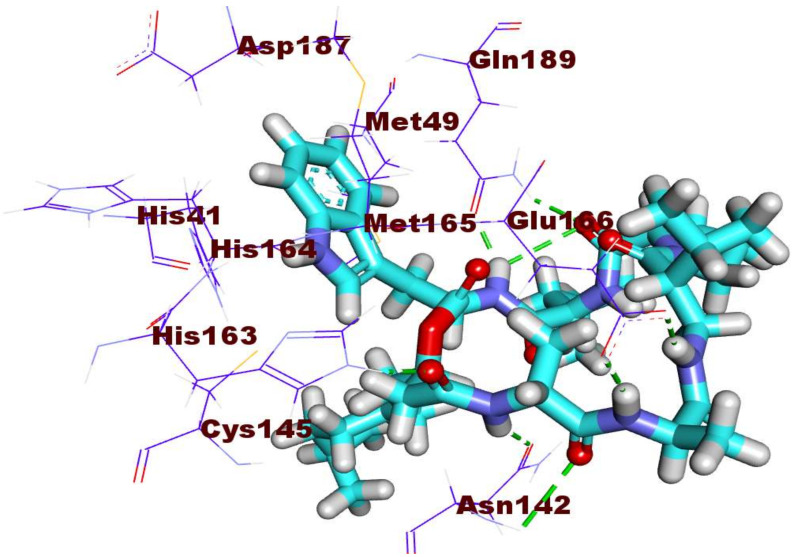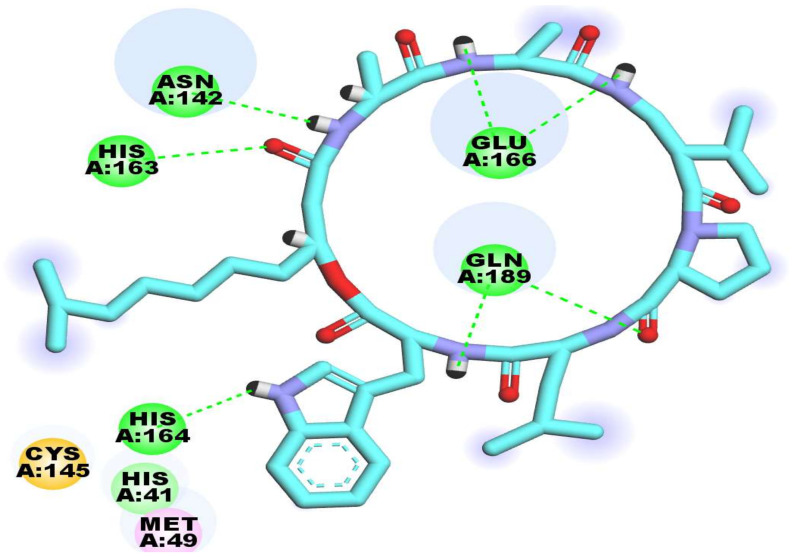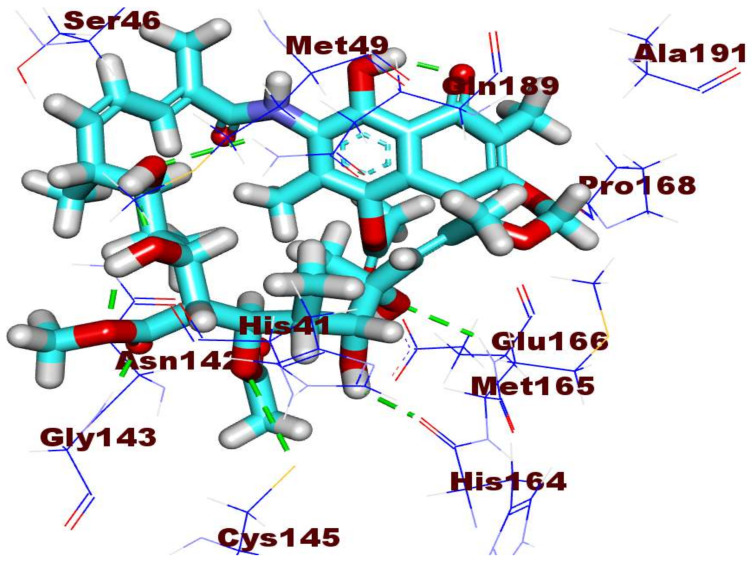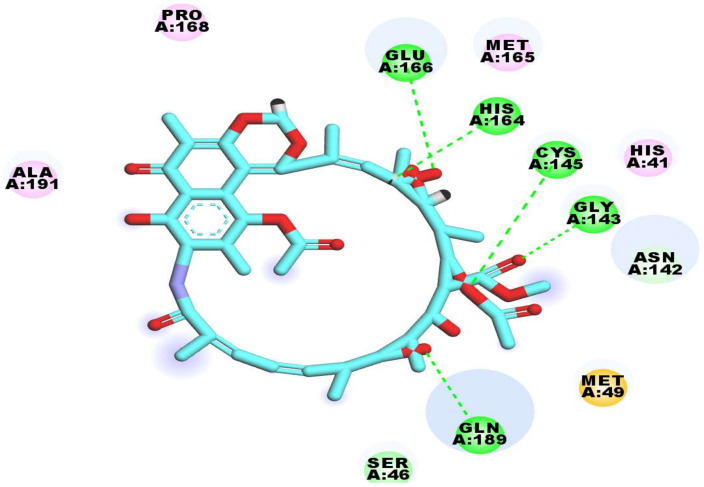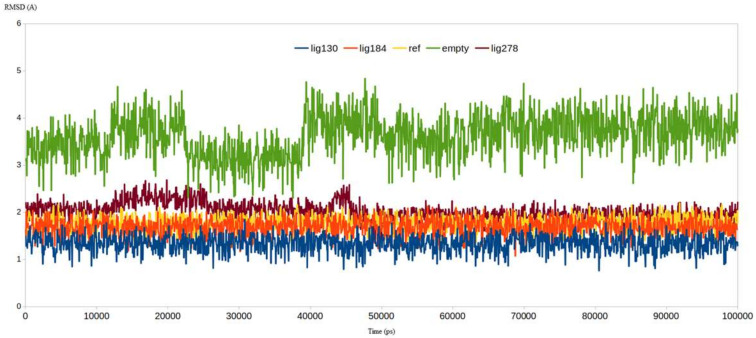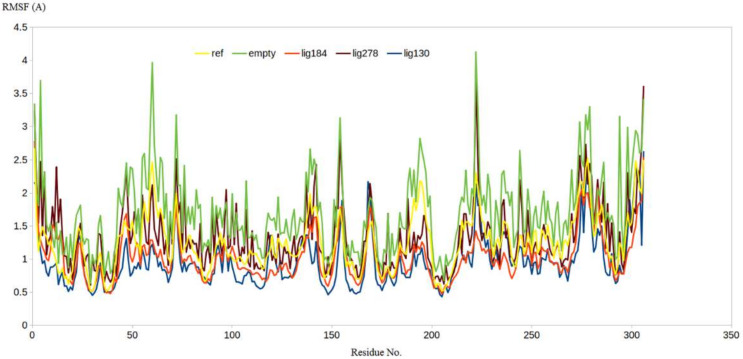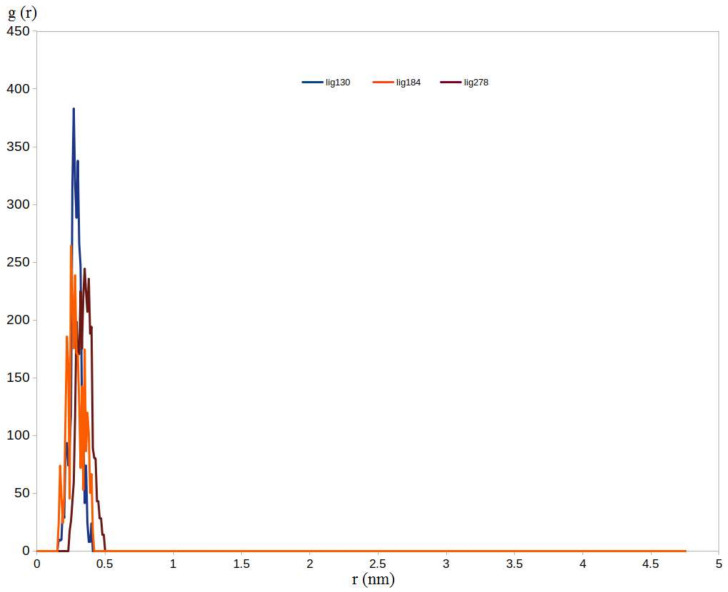Abstract
In continuation of our antecedent work against COVID-19, three natural compounds, namely, Luteoside C (130), Kahalalide E (184), and Streptovaricin B (278) were determined as the most promising SARS-CoV-2 main protease (Mpro) inhibitors among 310 naturally originated antiviral compounds. This was performed via a multi-step in silico method. At first, a molecular structure similarity study was done with PRD_002214, the co-crystallized ligand of Mpro (PDB ID: 6LU7), and favored thirty compounds. Subsequently, the fingerprint study performed with respect to PRD_002214 resulted in the election of sixteen compounds (7, 128, 130, 156, 157, 158, 180, 184, 203, 204, 210, 237, 264, 276, 277, and 278). Then, results of molecular docking versus Mpro PDB ID: 6LU7 favored eight compounds (128, 130, 156, 180, 184, 203, 204, and 278) based on their binding affinities. Then, in silico toxicity studies were performed for the promising compounds and revealed that all of them have good toxicity profiles. Finally, molecular dynamic (MD) simulation experiments were carried out for compounds 130, 184, and 278, which exhibited the best binding modes against Mpro. MD tests revealed that luteoside C (130) has the greatest potential to inhibit SARS-CoV-2 main protease.
Keywords: COVID-19, main protease, molecular fingerprints, structural similarity, docking, MD simulations, MM-PBSA
1. Introduction
The WHO mentioned on 8 February 2022 that SARS-CoV-2 caused confirmed infections estimated by 396,558,014 people all over the globe and resulted in the death of an additional 5,745,032 [1]. The spreading of this notorious virus dramatically in addition to the shortage of effective treatment, mandates the utilization of new fast and efficient drug design strategies [2]. Computer-aided (computer-based, computational, or in silico) strategies in drug discovery represent quick and reliable approaches that could predict the bioactivity of any compound reducing the waste of effort, [3,4] time, and money. Computer-aided drug discovery approaches include molecular docking [5,6,7], molecular dynamic simulations [8], QSAR [9], pharmacophore modeling [10,11], ADMET [12,13], DFT [14], drug molecular design [15,16], and toxicity prediction [17,18,19]. These approaches target the enhancement of drug activity besides the discovery of new ligands [20].
Humans always depended on nature around them as the main source of food and medicine [21,22]. The compounds isolated from natural sources showed various bioactivities like anticancer [23,24,25,26,27], antileishmanial [28,29], antibacterial [30,31,32], neuro-protecting [33,34], antioxidant [35], and antiviral activity [36,37].
Viral proteases are successfully utilized as promising antiviral targets. For instance, the aspartyl protease and the serine proteases were effective targets for antivirals against human immunodeficiency virus and hepatitis C virus, respectively [38]. The vital role of Mpro during the replication of SARS-CoV-2 is to activate a group of sixteen functional and non-structural proteins through the separation of the two overlying polyproteins (pp1a and pp1ab). Consequently, the inhibition of Mpro will cause definite damage to the virus [39]. Additionally, the structure and the sequence of viral main protease (Mpro) and human proteases are quietly different [40]. These properties suggest Mpro as a target for anti-COVID-19 drug discovery [41,42].
Our team used the computer-aided drug discovery approaches in the discovery of potential natural COVID-19 inhibitors several times. Four isoflavonoids with inhibitory potential against hACE2 and viral main protease have been selected among fifty-nine compounds [43]. Similarly, the anti-COVID-19 activity of fifteen guanidine alkaloids was screened in silico against five essential COVID-19 proteins [44]. Recently, our team utilized multistage in silico filtration techniques to point out the most potent natural inhibitor among a big group of compounds against certain COVID-19 enzymes. For instance, among a group of 310 natural antivirals, vidarabine was found to be the most promising natural inhibitor of SARS-CoV-2 nsp10 [45]. Similarly, the most relevant semisynthetic SARS-CoV-2 papain-like protease inhibitor has been chosen among 69 candidates [46].
PRD_002214,N-[(5-Methylisoxazol-3-yl)carbonyl]alanyl-l-valyl-N~1~-((1R,2Z)-4-(benzyloxy)-4-oxo-1-{[(3R)-2-oxopyrrolidin-3-yl]methyl}but-2-enyl)-l-leucinamide, also called inhibitor N3, is an irreversible peptide-like inhibitor of the main protease (MPRO) of SARS-CoV-2. The chemical structure of PRD_002214 was obtained from the RCSB Protein Data Bank entry 6LU7 which shows the ligand in complex with the main protease [47].
In this work, a collection of 310 naturally originated antiviral compounds has been screened using different computational methods to detect the most potent naturally derived Mpro inhibitor. The utilized methods included molecular structures similarity study with PRD_002214, a fingerprint study against PRD_002214, the molecular docking against Mpro PDB ID: 6LU7, in silico toxicity studies, and molecular dynamic (MD) simulation experiments (Figure 1).
Figure 1.
The utilized computational methods.
2. Results and Discussion
2.1. Structural Similarity Detection
Structural similarity is a computational method that identifies the similarity of two compounds based on structural molecular properties (descriptors) [48]. Recently, this method has become a considerable and effective method in the field of drug design [49]. The applied molecular descriptors included hydrogen bond donors (HBA) [50], hydrogen bond acceptors (HBD) [51], partition coefficient (ALog p) [52], molecular weight (M. Wt) [53], molecular fractional polar surface area (MFPSA) [54], and number of rotatable bonds [55], rings, and aromatic rings [56].
The degree of molecular similarity between two molecules depends on the similarity coefficient (metric) which is used to compute a quantitative score for the degree of similarity based on the weighted values of structural descriptors. The similarity between two molecules is the inverse function of the distance between them in descriptor space [57]. When there are two or more reference ligands, the shortest distance to a reference ligand is used. In this work, Euclidean distances between the rank-ordering of different descriptors are calculated to determine descriptor similarity where Euclidean distances represent the shortest distance between two points [58]. Structural similarity studies between the 310 antiviral compounds (Supplementary Materials Figure S1) and the co-crystallized ligand PRD_002214 (Figure 2) of Mpro PDB ID: 6LU7 have been applied by the software Discovery Studio depending on the previous descriptors.
Figure 2.
The chemical structure of PRD_002214.
The antiviral compounds were examined in six groups (Figure 3) and a similarity check was performed for each group separately using PRD_002214 as a reference. The distance between PRD_002214 and the tested compounds is illustrated in Figure 3. The results favored thirty compounds that have good structural similarity with PRD_002214 (Figure 4). The values of molecular properties for compounds are listed in Table 1.
Figure 3.
Results of the structural similarity of the antiviral compounds and PRD_002214. The green sphere is PRD_002214, the red sphere is a similar compound, and the blue sphere is a dissimilar compound. (A) first 50 compounds, (B) second 50 compounds, (C) third 50 compounds, (D) fourth 50 compounds, (E) fifth 50 compounds, and (F) sixth 60 compounds.
Figure 4.
The filtered 30 compounds obtained from the molecular similarity technique.
Table 1.
The calculated molecular properties of compounds having structural similarity with PRD_002214.
| Comp. | ALog p | M. Wt | HBA | HBD | Rotatable Bonds | Rings | Aromatic Rings | MFPSA | Minimum Distance |
|---|---|---|---|---|---|---|---|---|---|
| 3 | 2.91 | 313.348 | 4 | 3 | 6 | 2 | 2 | 0.239 | 1.802 |
| 7 | 0.857 | 546.629 | 9 | 3 | 11 | 5 | 1 | 0.223 | 1.053 |
| 17 | 3.911 | 444.522 | 4 | 2 | 11 | 3 | 3 | 0.183 | 1.382 |
| 49 | 3.714 | 481.647 | 5 | 1 | 7 | 5 | 2 | 0.11 | 1.682 |
| 50 | 3.387 | 465.604 | 5 | 2 | 6 | 5 | 2 | 0.132 | 1.689 |
| 85 | 0.436 | 446.404 | 10 | 5 | 5 | 4 | 2 | 0.373 | 1.801 |
| 94 | 3.743 | 372.412 | 6 | 1 | 7 | 3 | 2 | 0.192 | 1.804 |
| 95 | 2.879 | 388.411 | 7 | 2 | 7 | 3 | 2 | 0.235 | 1.671 |
| 96 | 3.513 | 444.431 | 9 | 0 | 10 | 4 | 2 | 0.225 | 1.515 |
| 97 | 3.474 | 442.415 | 9 | 0 | 9 | 4 | 2 | 0.226 | 1.586 |
| 128 | −0.546 | 798.738 | 20 | 10 | 16 | 5 | 2 | 0.407 | 0.703 |
| 129 | −0.925 | 756.702 | 19 | 11 | 14 | 5 | 2 | 0.425 | 0.795 |
| 130 | −0.699 | 770.728 | 19 | 10 | 15 | 5 | 2 | 0.396 | 0.704 |
| 131 | 0.484 | 624.587 | 15 | 9 | 11 | 4 | 2 | 0.414 | 0.726 |
| 132 | 0.484 | 624.587 | 15 | 9 | 11 | 4 | 2 | 0.413 | 0.725 |
| 156 | 2.489 | 464.635 | 6 | 5 | 5 | 4 | 0 | 0.236 | 0.888 |
| 157 | 1.195 | 480.634 | 7 | 6 | 5 | 4 | 0 | 0.27 | 0.884 |
| 158 | 1.137 | 480.634 | 7 | 6 | 5 | 4 | 0 | 0.266 | 0.886 |
| 180 | 3.176 | 944.185 | 12 | 5 | 13 | 3 | 1 | 0.232 | 0.674 |
| 184 | 4.986 | 836.071 | 8 | 6 | 11 | 4 | 2 | 0.23 | 0.623 |
| 203 | −0.499 | 503.583 | 10 | 4 | 8 | 3 | 0 | 0.268 | 1.002 |
| 204 | −0.091 | 517.61 | 10 | 3 | 9 | 3 | 0 | 0.237 | 0.999 |
| 210 | 3.874 | 512.638 | 6 | 1 | 13 | 3 | 2 | 0.188 | 0.902 |
| 237 | 3.511 | 557.073 | 9 | 2 | 8 | 4 | 0 | 0.235 | 1.025 |
| 248 | 3.607 | 605.642 | 7 | 3 | 7 | 4 | 0 | 0.156 | 1.038 |
| 264 | 5.732 | 470.598 | 6 | 2 | 10 | 2 | 1 | 0.172 | 0.723 |
| 276 | 3.062 | 557.03 | 10 | 1 | 19 | 1 | 0 | 0.24 | 0.717 |
| 277 | 1.804 | 754.797 | 14 | 5 | 6 | 4 | 2 | 0.295 | 0.604 |
| 278 | 2.745 | 811.868 | 15 | 6 | 6 | 4 | 1 | 0.288 | 0.692 |
| 280 | −0.367 | 480.523 | 5 | 7 | 10 | 3 | 3 | 0.359 | 0.649 |
| PRD_002214 | 2.453 | 680.791 | 8 | 5 | 18 | 3 | 2 | 0.273 | - |
The selected 30 antiviral compounds are isolated from different natural sources including plants, marine organisms, and microbes, and were reported to exhibit promising antiviral activities. Sources and antiviral potentialities of the selected compounds are summarized in Table 2.
Table 2.
Natural sources and antiviral activities of the most similar antiviral compounds.
| No. | Name and Type | Source | Antiviral Activity |
|---|---|---|---|
| 3 | Moupinamide, an alkaloid | Mollinedia sp. [59] | Showed in silico inhibition against Mpro 6Y84 and the spike protein 6LXT) [60] |
| 7 | Homoharringtonine, an alkaloid | Cephalotaxus genus [61] | Inhibited the replication of SARS-CoV-2 (in vitro) with an EC50 value of 2.55 μM [62] |
| 17 | Aurantiamide acetate, a dipeptide | Pongamia glabra flowers [63] and Aspergillus sp [64] | In vitro inhibited the replication of Influenza A virus in MDCK cells [65] |
| 49 | Emetine, an alkaloid | Cephaelis ipecacuanha roots [66] | Inhibited SARS-CoV-2 replication in vitro with an EC50 of 0.46 μM [62] Inhibited SARS-CoV-2 protein synthesis and interaction of viral mRNA [67] |
| 50 | Psychotrine, an alkaloid | Cephaelis acuminata [68] | Inhibited COVID-19 Mpro in silico (ΔG = −3.5 kcal. mol−1) [69] |
| 85 | 5-O-Methylgenistein-7-glucoside, an isoflavonoid | Ulex europaeus [70] | Inhibited herpes simplex virus (HSV) in vitro [70] |
| 94 | Arctigenin, a lignan | Arctium lappa [71] | In vivo inhibited influenza virus through interferon production [72]. Inhibited Spring viraemia of carp virus (SVCV) through inhibition of autophagy [73] |
| 95 | Trachelogenin, a lignan | Ipomoea cairica [74] | Inhibited the entry of hepatitis C virus through CD81 [75] |
| 96 | Rhinacanthin-F, a lignan | Rhinacanthus nasutus [76] | Inhibited of influenza virus type A [76] |
| 97 | Rhinacanthin-E, a lignan | ||
| 128 | Luteosides A, B and C phenylpropanoid glycosides |
Markhamia lutea [77] | Showed an in vitro inhibition of respiratory syncytial virus [77] |
| 129 | |||
| 130 | |||
| 131 | Verbascoside, a phenylpropanoid | Verbascum olympicum [78] and Markhamia lutea [77] | Inhibited in vitro herpes HSV-1, HSV-2 [79] and a respiratory syncytial virus [77] |
| 132 | Isoverbascoside, a phenylpropanoid | In vitro inhibited the respiratory syncytial virus [77] | |
| 156 | Ponasterone A, a triterpenoidal saponins |
Podocarpus macrophyllus [80] Acrostichum aureum [81] |
Inhibited HIV-1 gene expression in mammalian cells [82] |
| 157 | Pterosterone, a triterpenoidal saponins | Exhibited an inhibition against (HIV-1) infection as CCR5 inhibitors [83] | |
| 158 | Ecdysterone, a riterpenoidal saponins | Diploclisia glaucescens [84] | Inhibited HIV-1 in vitro [70] |
| 180 | Didemnin A, a peptide (depsipeptide) | Caribbean tunicate Trididemnum solidum [85] |
Inhibited Coxsackie virus and equine rhinovirus in vitro [85] Inhibited both RNA and DNA viruses and HSV-2 in vitro [86] |
| 184 | Kahalalide E, a peptide | Marine Mollusk Elysia rufescens [87] | Inhibited HSV-2 in vitro [88] |
| 203 | Mycalamide A, an alkaloid | of the genus Mycale [89] | Inhibited SARS-CoV-1 in vitro with an IC50 of 0.2 µg kg−1 [90] and at a concentration of 5 ng/disc it stopped HSV-1 and Polio type I viruses [91] |
| 204 | Mycalamide B, an alkaloid | At a concentration of 2 ng/disc, it stopped HSV-1 and Polio-1 viruses [91] | |
| 210 | Hennoxazole A, an alkaloid | A sponge Polyfibrospongia sp [92] | In vitro inhibited HSV-1 (IC50 of 0.6 lg/mL) [92] |
| 237 | Solenolide A, a diterpene | Marine Octocoral of the Genus Solenopodium [93] | In silico inhibition of Mpro PDB Id: 6LU7 with a binding free energy of −10.8 kcal. mol−1 [94] |
| 248 | Thyrsiferol, a triterpene | The red algae Laurencia thyrsifera [95] | In vitro inhibited VSV and HSV-1 at levels of 0.l-0μg/well and slight activity against A59 coronavirus [96] |
| 264 | Usneoidol Z a meroterpene | Brown Seaweed Cystoseira usneoides [97,98] | In vitro inhibited HSV-l/CV-I at concentrations of 20 and 10 μg/disk, respectively [98] |
| 276 | Punaglandin-1, an eicosanoid | The octocoral Telesto riisei [99] | Inhibited HSV in vitro [70] |
| 277 | Rifamycin B, a macrolide | The bacterium Amycolatopsis rifamycinica [100] | Inhibited (in vitro) murine sarcoma virus through cell transformation inhibition [101] |
| 278 | Streptovaricin B, an ansamycin | Streptomyces spectabilis, an actinomycete [102] | Stopped poxviruses replication through the inhibition of mRNA synthesis in early stages [101] |
| 280 | Distamycin A, an oligopeptide | Streptomyces netropsis [103] | Inhibited transcription and replication of different viruses [104] and inhibited the post-replicative mRNA synthesis of vaccinia virus [105] |
2.2. Structural Fingerprint Study
The fingerprints technique was applied using Discovery Studio software to identify the molecular structures (2D) of the similar 30 antiviral compounds in a binary format against PRD_002214. The examined descriptors were HBA and HBD [106], charge [107], hybridization [108], positive and negative ionizable groups [109], halogens, aromatics, or none of the above, and the ALogP category [110] of atoms. The study (Table 3) showed that the antiviral compounds 7, 128, 130, 156, 157, 158, 180, 184, 203, 204, 210, 237, 264, 276, 277, and 278 were the most favorite.
Table 3.
Degree of fingerprint similarity between the antiviral compounds and PRD_002214.
| Comp. | Similarity | SA | SB | SC |
|---|---|---|---|---|
| PRD_002214 | 1 | 1116 | 0 | 0 |
| 7 | 0.683 | 772 | 15 | 344 |
| 128 | 0.648 | 926 | 313 | 190 |
| 130 | 0.651 | 889 | 249 | 227 |
| 156 | 0.652 | 818 | 139 | 298 |
| 157 | 0.654 | 824 | 143 | 292 |
| 158 | 0.644 | 819 | 156 | 297 |
| 180 | 0.718 | 1509 | 987 | −393 |
| 184 | 0.800 | 1372 | 599 | −256 |
| 203 | 0.654 | 755 | 39 | 361 |
| 204 | 0.644 | 780 | 95 | 336 |
| 210 | 0.666 | 748 | 7 | 368 |
| 237 | 0.676 | 868 | 168 | 248 |
| 264 | 0.681 | 725 | −52 | 391 |
| 276 | 0.665 | 859 | 176 | 257 |
| 277 | 0.758 | 1026 | 237 | 90 |
| 278 | 0.724 | 1207 | 550 | −91 |
SA: The bits number that was computed in the antiviral compounds and PRD_002214. SB: The bits number that was computed in the antiviral compounds but not PRD_002214. SC: The bits number that was computed in PRD_002214 but not in the antiviral compounds.
2.3. Docking Studies
Docking studies were proceeded to inspect the binding free energies (∆G) and the binding modes [111,112,113,114,115,116] of the antiviral compounds against Mpro PDB ID: 6LU7 (Table 4) with PRD_002214 as a reference. Eight compounds (128, 130, 156, 180, 184, 203, 204, and 278) exhibited the most a-like binding mode and the highest binding energies.
Table 4.
The computed values of ∆G of the antiviral compounds and the co-crystallized ligand against Mpro.
| Compound | ∆G (kcal. mol−1) | Compound | ∆G (kcal. mol−1) |
|---|---|---|---|
| 7 | −25.20 | 204 | −33.03 |
| 128 | −29.53 | 210 | −28.41 |
| 130 | −32.99 | 237 | −23.75 |
| 156 | −29.09 | 264 | −25.85 |
| 157 | −24.19 | 276 | −21.66 |
| 158 | −26.98 | 277 | −24.08 |
| 180 | −34.15 | 278 | −29.00 |
| 184 | −30.15 | PRD_002214 | −31.31 |
| 203 | −31.20 |
Starting with PRD_002214, it showed eight hydrogen bonds in addition to four hydrophobic reactions. In detail, the first pocket of Mpro was occupied by the 2-oxopyrrolidin-3-yl moiety that was involved in two hydrogen-bonding interactions with His163 and Glu166. The 2-acetamido-3-methylbutanamido)-N-ethyl-4-methyl pentanamide moiety was buried in the second pocket with four hydrogen-bonding interactions with Gln189, Glu166, and Thr190 together with three hydrophobic interactions with Met165 and His41. The benzyl acetate moiety was suited in the third pocket of the receptor engaging in two hydrogen bonds with His164 and His41. Moreover, the 5-methylisoxazole-3-carboxamide moiety occupied the fourth pocket forming a hydrophobic interaction with Ala191 (Figure 5) [117].
Figure 5.
The binding pattern of PRD_002214 inside the 6LU7 active site of Mpro PDB ID: 6LU7 active site.
The antiviral compound, 130 was engaged in six hydrogen bonds, three hydrophobic interactions, and one electrostatic attraction. Firstly, the methyl-3-(4-hydroxy-3-methoxyphenyl)acrylate moiety was fitted in the first pocket making two hydrogen bonds with His 163 and Thr26 and one electrostatic interaction with Cys145. Furthermore, the 6-methyltetrahydro-2H-pyran-3,4,5-triol moiety was engaged in two hydrogen-bonding interactions inside the second pocket with His 164 and Met165 in addition to hydrophobic interactions (three) with Met49 and His41. Additionally, compound 130 was involved in two hydrogen bonds with Glu166 in the third pocket. Finally, the (3R,4R)-3-(hydroxymethyl)tetrahydrofuran-3,4-diol was buried in the fourth pocket (Figure 6).
Figure 6.
The binding pattern of compound 130 inside the Mpro PDB ID: 6LU7 active site.
The antiviral compound 184 (affinity value of −30.15 kcal/mol) revealed the engagement in many H-bonding as well as hydrophobic interactions in the different pockets of the main protease active pocket. At first, the 2-acetamido-N-((1-(isopentylamino)-1- oxopropan-2-yl)propanamide moiety was involved in four hydrogen bonds with Glu166, Asn142, and His 163 in the first pocket. Likely, the 2-formamido-N,4-dimethyl pentanamide moiety made two hydrogen bonds with Gln189 in the second pocket. Moreover, compound 184 was buried in the second pocket through the formation of one hydrogen bond with the amino acid Met165 and two hydrophobic interactions with the amino acid Met49 using its 1H-indole moiety (Figure 7).
Figure 7.
The binding pattern of compound 184 inside the Mpro PDB ID: 6LU7 active site.
The antiviral compound 278 exhibited a ∆G of −29.00 kcal. mol−1. It was combined with receptor protein through five hydrogen bonds and four hydrophobic interactions as shown in Figure 8. Basically, the 7-hydroxy-5,9-dimethyl-6H-naphtho [2,1-d][1,3]dioxin -6-one occupied the first pocket of COVID-19 main protease with two hydrophobic interactions with Pro168 and Ala191. The macrocyclic structure of the tested compounds occupied the other three pockets of the target receptor engaging in five hydrogen bonds with Glu166, His164, Cys145, Gly143, and Gln189. Moreover, it formed two hydrophobic interactions with Met165 and His41.
Figure 8.
Binding mode of compound 278 inside the active site of Mpro PDB ID: 6LU7.
The detailed binding modes of compounds 128, 156, 180, 203, and 204 are displayed in the Supplementary Materials (Figures S2–S6, respectively).
2.4. Toxicity Models
In this experiment, the toxicity profiles of the favored eight antiviral compounds (128, 130, 156, 180, 184, 203, 204, and 278) were examined by seven toxicity models (illustrated in Table 5) in the Discovery Studio software version 4.0 [118,119].
Table 5.
Toxicity models of the antiviral compounds and the reference drug.
| Comp. | 128 | 130 | 156 | 180 | 184 | 203 | 204 | 278 | Simeprevir |
|---|---|---|---|---|---|---|---|---|---|
| FDA rodent carcinogenicity | Non-Carcinogen | ||||||||
| Median carcinogenic potency (TD50), mg/kg/day | 2.871 | 1.854 | 5.663 | 8.687 | 3.037 | 7.360 | 12.564 | 12.946 | 2.014 |
| Rat maximum tolerated dose, g/kg body weight | 2.382 | 1.277 | 0.137 | 0.002 | 0.021 | 0.018 | 0.029 | 0.020 | 0.003 |
| Rat lethal dose (LD50) g/kg body weight |
4.282 | 5.717 | 10.020 | 0.274 | 4.897 | 0.141 | 0.324 | 0.166 | 0.209 |
| Rat chronic lowest observed adverse effect level (LOAEL), g/kg body weight | 0.040 | 0.017 | 0.017 | 0.001 | 0.012 | 0.001 | 0.001 | 0.001 | 0.002 |
| Ocular irritancy | Mild | Mild | Moderate | Moderate | None | Mild | Mild | Mild | Mild |
| Skin irritancy | Mild | Mild | Moderate | Mild | None | Mild | Mild | None | None |
All the examined antiviral compounds were estimated as non-carcinogenic in the FDA rodent carcinogenicity model. Additionally, all antiviral compounds except 130 showed TD50 values more than simeprevir where the values were ranging from 2.871 to 12.946 g/kg body. Furthermore, all antiviral compounds except 180 showed rat maximum tolerated dose values higher than that of simeprevir, the values were ranging from 0.018 to 2.382 g/kg body weight. Compounds 128, 130, 156, 180, 184, and 204 revealed oral LD50 values in a range of 0.274 to 10.020 g/kg body weight, higher than that of simeprevir (0.209 g/kg body weight). On the other hand, compounds 203 and 278 showed oral LD50 values of 0.141 and 0.166 g/kg body weight, respectively which were lower than that of simeprevir. Compounds 128, 130, 156, and 184 showed LOAEL values ranging from 0.012 to 0.040 g/kg body weight while simeprevir exhibited 0.002 g/kg body weight. Finally, all the antiviral compounds showed mild to moderate irritancy except 184 which showed no irritancy in both models (Table 5).
2.5. Molecular Dynamics
Molecular dynamics (MD) simulation has provided many valuable insights into the binding of drugs to their targets. This includes accurate evaluation of the binding strength between a ligand and its target, studying the nature of macromolecules, and characterizing the effect of certain mutations on the resistance profile of many drugs [120,121]. In this test, three compounds (130, 184, and 278) that exhibited good binding mode against Mpro were nominated for MD simulation studies.
2.5.1. RMSD, RMSF, and RDF Analysis
To endorse our virtual screening approach so far, five MD simulation experiments were conducted on the free Mpro, co-crystallized ligand-Mpro, 130-Mpro, 184-Mpro, and 278-Mpro. Interestingly, the calculated RMSD for the free Mpro exceeded 4.8 Å while the RMSD of the co-crystalized ligand-Mpro reached nearly 2.2 Å. As expected, the RMSD of 130-Mpro and 184-Mpro reached only 1.7 and 2.1 Å, respectively. In contrast, the 278-Mpro complex had the highest RMSD value among the four ligands, reaching about 2.7 Å (Figure 9). The complex 130-Mpro showed the least RMSD value which is a good indicator of its ability to further restrict the flexibility of Mpro compared to the co-crystalized ligand. Furthermore, its ability to stabilize the Mpro is attributed to the strong binding mode between the Mpro and compound 130.
Figure 9.
RMSD analysis for the MD simulations for the native enzyme (green), PRD_002214 (yellow), 130 (blue), 184 (orange), and 278 (brown).
Similar results were obtained when calculating the RMSF values for all the residues of the five systems where the native enzyme showed a significantly higher level of residues fluctuation during the simulation compared to the co-crystalized ligand and the three lead compounds (Figure 10). It is worth mentioning that the high flexibility of Mpro as shown by higher values for RMSD and RMSF is consistent with its intended function to process the resulting polyprotein from the replication cycle of the virus. Accordingly, the ability of compound 130 to produce lower values for RMSD and RMSF highlights its potentiality as a potent Mpro inhibitor.
Figure 10.
The RMSF analysis for the MD simulations for the native enzyme (orange), PRD_002214 (blue), 130 (brown), 184 (yellow), and 278 (green).
In addition to RMSD and RMSF calculations, the radial distribution function (RDF) was also computed to provide extra insights into the binding of the Mpro and the three selected compounds. RDF can explore the distance relationship (atom to atom) between two types of molecules (ligand, and receptor). The average density of ligand to protein (Mpro) surface in the stable period was computed by analyzing the RDF of each ligand to Mpro surface [122]. The gmx rdf program was utilized to explore the RDF of the three ligands to the surface of the Mpro, and the results are demonstrated in Figure 11. All of the RDF for the three ligands with the Mpro showed distinct peaks at 0.22~0.34 nm, a distance that enabled the three hits to form strong hydrogen bonds and hydrophobic interactions. Furthermore, among the three complexes, the 130-Mpro complex reached the highest peak nearly at 0.25 nm, followed by 184-Mpro and then 278-Mpro which reached their maximum peaks at 0.23 nm and 0.34 nm, respectively. To this end, the RDF also proves the ability of the three compounds to predominantly distribute at a distance that allows strong interactions with the Mpro and also highlights the superiority of compound 130 over compounds 184 and 278. In conclusion, the RDF calculations are highly matched with RMSD and RMSF calculations, endorsing the obtained results from the docking step.
Figure 11.
Radial distribution function (RDF) for the three ligands (130, 184, and 278) on the surface of the Mpro enzyme.
2.5.2. Binding Free Energy Calculations Using MM-PBSA Approach
The binding free energies between the four ligands (co-crystallized reference and the three retrieved lead compounds) with Mpro were computed from all the conformations in the saved trajectories utilizing the MM-PBSA approach. The g_mmpbsa package generated by Kumari et al. [123] was utilized to compute all the MM-PBSA binding free energy types (van der Waals, electrostatic, polar solvation, and SASA energies) for the four complexes of Mpro with the four ligands (Table 6). The calculated binding energy showed a significant higher binding affinity for 130 and 184 compared to the co-crystalized ligand and 278 which is consistent with the obtained results of both docking and MD simulations.
Table 6.
Interaction energies and the binding free energy for the four complexes.
| Complex | ΔE Binding (kj/mol) | ΔE Electrostatic (kj/mol) | ΔE Vander Waal (kj/mol) | ΔE Polar Solvation (kj/mol) | SASA (kJ/mol) |
|---|---|---|---|---|---|
| 130 | −286.9 ± 10.2 | −139.1 ± 9.8 | −245.7 ± 12.3 | 125.2 ± 8.1 | −27.3 ± 0.9 |
| 184 | −271.8 ± 8.9 | −131.1 ± 9.1 | −238.9 ± 8.5 | 124.9 ± 6.2 | −26.7 ± 1.1 |
| 278 | −236.6 ± 10.4 | −111.8 ± 11.3 | −205.6 ± 9.4 | 102.1 ± 10.7 | −21.3 ± 0.8 |
| PRD_002214 | −252.5 ± 9.1 | −119.5 ± 8.7 | −226.7 ± 10.9 | 114.2 ± 7.4 | −20.5 ± 1.2 |
3. Method
3.1. Molecular Similarity Detection
Molecular Similarity detection was performed for the antiviral compounds using Discovery Studio software as described in the Supplementary Materials.
3.2. Molecular Fingerprint Detection
Molecular fingerprint detection was performed for the antiviral compounds using Discovery Studio software as described in the Supplementary Materials.
3.3. Docking Studies
Docking studies of the antiviral compounds were carried out for the antiviral compounds against SARS-CoV-2 main protease PDB ID: 6LU7 using MOE.14 software [124,125,126,127] as shown in the Supplementary Materials.
3.4. Toxicity Studies
In silico toxicity profiles were calculated for the antiviral compounds using Discovery Studio 4.0 [128,129,130] as shown in the Supplementary Materials.
3.5. MDS
All molecular dynamics (MD) simulations were performed for the antiviral compounds using the GROningen MAchine as shown in the Supplementary Materials.
4. Conclusions
Herein, it was concluded that luteoside C (130) was found to be the most potent inhibitor of Mpro among a collection of 310 natural antiviral compounds depending on a multi-phase in silico approach. The molecular structures similarity study against PRD_002214, the ligand of the target enzyme, favored thirty compounds. Then, the fingerprint study against PRD_002214 elected the most similar sixteen compounds. The molecular docking against Mpro PDB ID: 6LU7 and toxicity studies favored eight compounds. The MD simulations experiments were carried out and revealed the superiority of 130 as the most potent inhibitor of Mpro. Although the in vitro and in vivo examinations against COVID-19 are not accessible for our team, we depended on extensive well-structured in silico studies to offer all scientists who have the facilities the chance of strongly potential SARS-CoV-2 inhibitors. Our research is an important initial step that could be very helpful in the journey of finding a cure.
Acknowledgments
The authors extend their appreciation to the Research Center at AlMaarefa University for funding this work.
Supplementary Materials
The chemical structures of the tested compounds, detailed method in addition to the toxicity report can be downloaded at: https://www.mdpi.com/article/10.3390/ijms23136912/s1.
Author Contributions
Conceptualization, I.H.E., A.M.M. and H.E.; Data curation, M.L.A.; Formal analysis, I.H.E., M.A.E.H. and S.M.A.-S.; Funding acquisition, A.A.A.; Investigation, H.E., E.B.E., M.L.A. and M.A.E.H.; Methodology, I.H.E., H.E., E.B.E.; Project administration, I.H.E. and S.M.A.-S.; Software, I.H.E., H.E., M.A.E.H. and S.M.A.-S.; Supervision, F.S.Y., M.L.A. and A.M.M.; Writing—original draft, I.H.E., A.M.M.; Writing—review & editing, A.A.A., E.B.E., F.S.Y., M.A.E.H. and S.M.A.-S. All authors have read and agreed to the published version of the manuscript.
Institutional Review Board Statement
Not applicable.
Informed Consent Statement
Not applicable.
Data Availability Statement
Data are avilabe with the corresponding author upon request.
Conflicts of Interest
The authors declare no competing interests.
Funding Statement
This research was funded by Princess Nourah bint Abdulrahman University Researchers Supporting Project number (PNURSP2022R116), Princess Nourah bint Abdulrahman University, Riyadh, Saudi Arabia.
Footnotes
Publisher’s Note: MDPI stays neutral with regard to jurisdictional claims in published maps and institutional affiliations.
References
- 1.WHO WHO Coronavirus (COVID-19) Dashboard. [(accessed on 9 February 2022)]. Available online: https://covid19.who.int/
- 2.Alsaif N.A., Taghour M.S., Alanazi M.M., Obaidullah A.J., Al-Mehizia A.A., Alanazi M.M., Aldawas S., Elwan A., Elkady H. Discovery of new VEGFR-2 inhibitors based on bis ([1, 2, 4] triazolo)[4, 3-a: 3′, 4′-c] quinoxaline derivatives as anticancer agents and apoptosis inducers. J. Enzyme Inhib. Med. Chem. 2021;36:1093–1114. doi: 10.1080/14756366.2021.1915303. [DOI] [PMC free article] [PubMed] [Google Scholar]
- 3.Belal A. 3D-Pharmacophore Modeling, Molecular Docking, and Virtual Screening for Discovery of Novel CDK4/6 Selective Inhibitors. Russ. J. Bioorg. Chem. 2021;47:317–333. doi: 10.1134/S1068162021330013. [DOI] [Google Scholar]
- 4.Belal A. Pyrrolizines as Potential Anticancer Agents: Design, Synthesis, Caspase-3 activation and Micronucleus (MN) Induction. Anti-Cancer Agents Med. Chem. 2018;18:2124–2130. doi: 10.2174/1871520618666180409155520. [DOI] [PubMed] [Google Scholar]
- 5.Marrone T.J., Briggs A.J.M., McCammon J.A. Structure-based drug design: Computational advances. Annu. Rev. Pharmacol. Toxicol. 1997;37:71–90. doi: 10.1146/annurev.pharmtox.37.1.71. [DOI] [PubMed] [Google Scholar]
- 6.Li N., Wang Y., Li W., Li H., Yang L., Wang J., Mahdy H.A., Mehany A., Jaiash D.A., Santali E.Y. Screening of Some Sulfonamide and Sulfonylurea Derivatives as Anti-Alzheimer’s Agents Targeting BACE1 and PPARγ. J. Chem. 2020;2020:1631243. doi: 10.1155/2020/1631243. [DOI] [Google Scholar]
- 7.Abdel-Aziz H.A., Eldehna W.M., Fares M., Al-Rashood S.T., Al-Rashood K.A., Abdel-Aziz M.M., Soliman D.H. Synthesis, biological evaluation and 2D-QSAR study of halophenyl bis-hydrazones as antimicrobial and antitubercular agents. Int. J. Mol. Sci. 2015;16:8719–8743. doi: 10.3390/ijms16048719. [DOI] [PMC free article] [PubMed] [Google Scholar]
- 8.Durrant J.D., McCammon J.A. Molecular dynamics simulations and drug discovery. BMC Biol. 2011;9:71. doi: 10.1186/1741-7007-9-71. [DOI] [PMC free article] [PubMed] [Google Scholar]
- 9.Hadni H., Elhallaoui M. 2D and 3D-QSAR, molecular docking and ADMET properties in silico studies of azaaurones as antimalarial agents. New J. Chem. 2020;44:6553–6565. doi: 10.1039/C9NJ05767F. [DOI] [Google Scholar]
- 10.Yadav D.K., Khan F., Negi A.S. Pharmacophore modeling, molecular docking, QSAR, and in silico ADMET studies of gallic acid derivatives for immunomodulatory activity. J. Mol. Modeling. 2012;18:2513–2525. doi: 10.1007/s00894-011-1265-3. [DOI] [PubMed] [Google Scholar]
- 11.Belal A., Elanany M.A., Santali E.Y., Al-Karmalawy A.A., Aboelez M.O., Amin A.H., Abdellattif M.H., Mehany A.B., Elkady H. Screening a Panel of Topical Ophthalmic Medications against MMP-2 and MMP-9 to Investigate Their Potential in Keratoconus Management. Molecules. 2022;27:3584. doi: 10.3390/molecules27113584. [DOI] [PMC free article] [PubMed] [Google Scholar]
- 12.Alsaif N.A., Dahab M.A., Alanazi M.M., Obaidullah A.J., Al-Mehizia A.A., Alanazi M.M., Aldawas S., Mahdy H.A., Elkady H. New quinoxaline derivatives as VEGFR-2 inhibitors with anticancer and apoptotic activity: Design, molecular modeling, and synthesis. Bioorg. Chem. 2021;110:104807. doi: 10.1016/j.bioorg.2021.104807. [DOI] [PubMed] [Google Scholar]
- 13.El-Adl K., Ibrahim M.-K., Alesawy M.S., Eissa I.H. [1, 2, 4] Triazolo [4, 3-c] quinazoline and bis ([1, 2, 4] triazolo)[4, 3-a: 4′, 3′-c] quinazoline derived DNA intercalators: Design, synthesis, in silico ADMET profile, molecular docking and anti-proliferative evaluation studies. Bioorg. Med. Chem. 2021;30:115958. doi: 10.1016/j.bmc.2020.115958. [DOI] [PubMed] [Google Scholar]
- 14.Parmar D.R., Soni J.Y., Guduru R., Rayani R.H., Kusurkar R.V., Vala A.G., Talukdar S.N., Eissa I.H., Metwaly A.M., Khalil A. Discovery of new anticancer thiourea-azetidine hybrids: Design, synthesis, in vitro antiproliferative, SAR, in silico molecular docking against VEGFR-2, ADMET, toxicity, and DFT studies. Bioorg. Chem. 2021;115:105206. doi: 10.1016/j.bioorg.2021.105206. [DOI] [PubMed] [Google Scholar]
- 15.Zhang W., Pei J., Lai L. Computational multitarget drug design. J. Chem. Inf. Modeling. 2017;57:403–412. doi: 10.1021/acs.jcim.6b00491. [DOI] [PubMed] [Google Scholar]
- 16.Youssef M.I., Zhou Y., Eissa I.H., Wang Y., Zhang J., Jiang L., Hu W., Qi J., Chen Z. Tetradecyl 2, 3-dihydroxybenzoate alleviates oligodendrocyte damage following chronic cerebral hypoperfusion through IGF-1 receptor. Neurochem. Int. 2020;138:104749. doi: 10.1016/j.neuint.2020.104749. [DOI] [PubMed] [Google Scholar]
- 17.El-Metwally S.A., Abou-El-Regal M.M., Eissa I.H., Mehany A.B., Mahdy H.A., Elkady H., Elwan A., Elkaeed E.B. Discovery of thieno [2, 3-d] pyrimidine-based derivatives as potent VEGFR-2 kinase inhibitors and anti-cancer agents. Bioorg. Chem. 2021;112:104947. doi: 10.1016/j.bioorg.2021.104947. [DOI] [PubMed] [Google Scholar]
- 18.Alanazi M.M., Eissa I.H., Alsaif N.A., Obaidullah A.J., Alanazi W.A., Alasmari A.F., Albassam H., Elkady H., Elwan A. Design, synthesis, docking, ADMET studies, and anticancer evaluation of new 3-methylquinoxaline derivatives as VEGFR-2 inhibitors and apoptosis inducers. J. Enzyme Inhib. Med. Chem. 2021;36:1760–1782. doi: 10.1080/14756366.2021.1956488. [DOI] [PMC free article] [PubMed] [Google Scholar]
- 19.Alanazi M.M., Alaa E., Alsaif N.A., Obaidullah A.J., Alkahtani H.M., Al-Mehizia A.A., Alsubaie S.M., Taghour M.S., Eissa I.H. Discovery of new 3-methylquinoxalines as potential anti-cancer agents and apoptosis inducers targeting VEGFR-2: Design, synthesis, and in silico studies. J. Enzyme Inhib. Med. Chem. 2021;36:1732–1750. doi: 10.1080/14756366.2021.1945591. [DOI] [PMC free article] [PubMed] [Google Scholar]
- 20.Sliwoski G., Kothiwale S., Meiler J., Lowe E.W. Computational methods in drug discovery. Pharmacol. Rev. 2014;66:334–395. doi: 10.1124/pr.112.007336. [DOI] [PMC free article] [PubMed] [Google Scholar]
- 21.Metwaly A.M., Ghoneim M.M., Eissa I.H., Elsehemy I.A., Mostafa A.E., Hegazy M.M., Afifi W.M., Dou D. Traditional ancient Egyptian medicine: A review. Saudi J. Biol. Sci. 2021;28:5823–5832. doi: 10.1016/j.sjbs.2021.06.044. [DOI] [PMC free article] [PubMed] [Google Scholar]
- 22.Han X., Yang Y., Metwaly A.M., Xue Y., Shi Y., Dou D. The Chinese herbal formulae (Yitangkang) exerts an antidiabetic effect through the regulation of substance metabolism and energy metabolism in type 2 diabetic rats. J. Ethnopharmacol. 2019;239:111942. doi: 10.1016/j.jep.2019.111942. [DOI] [PubMed] [Google Scholar]
- 23.Suleimen Y.M., Metwaly A.M., Mostafa A.E., Elkaeed E.B., Liu H.-W., Basnet B.B., Suleimen R.N., Ishmuratova M.Y., Turdybekov K.M., Van Hecke K. Isolation, Crystal Structure, and In Silico Aromatase Inhibition Activity of Ergosta-5, 22-dien-3β-ol from the Fungus Gyromitra esculenta. J. Chem. 2021;2021:5529786. doi: 10.1155/2021/5529786. [DOI] [Google Scholar]
- 24.Metwaly A.M., Lianlian Z., Luqi H., Deqiang D. Black ginseng and its saponins: Preparation, phytochemistry and pharmacological effects. Molecules. 2019;24:1856. doi: 10.3390/molecules24101856. [DOI] [PMC free article] [PubMed] [Google Scholar]
- 25.Metwaly A.M., Wanas A.S., Radwan M.M., Ross S.A., ElSohly M.A. New α-Pyrone derivatives from the endophytic fungus Embellisia sp. Med. Chem. Res. 2017;26:1796–1800. doi: 10.1007/s00044-017-1889-7. [DOI] [Google Scholar]
- 26.Yassin A.M., El-Deeb N.M., Metwaly A.M., El Fawal G.F., Radwan M.M., Hafez E.E. Induction of apoptosis in human cancer cells through extrinsic and intrinsic pathways by Balanites aegyptiaca furostanol saponins and saponin-coated silvernanoparticles. Appl. Biochem. Biotechnol. 2017;182:1675–1693. doi: 10.1007/s12010-017-2426-3. [DOI] [PubMed] [Google Scholar]
- 27.Metwaly A.M., Fronczek F.R., Ma G., Kadry H.A., Atef A., Mohammad A.-E.I., Cutler S.J., Ross S.A. Antileukemic α-pyrone derivatives from the endophytic fungus Alternaria phragmospora. Tetrahedron Lett. 2014;55:3478–3481. doi: 10.1016/j.tetlet.2014.04.085. [DOI] [PMC free article] [PubMed] [Google Scholar]
- 28.Imieje V.O., Zaki A.A., Metwaly A.M., Eissa I.H., Elkaeed E.B., Ali Z., Khan I.A., Falodun A. Antileishmanial Derivatives of Humulene from Asteriscus hierochunticus with in silico Tubulin Inhibition Potential. Rec. Nat. Prod. 2021:150–171. [Google Scholar]
- 29.Metwaly A.M., Ghoneim M.M., Musa A. Two new antileishmanial diketopiperazine alkaloids from the endophytic fungus Trichosporum sp. Derpharmachemica. 2015;7:322. [Google Scholar]
- 30.Jalmakhanbetova R., Elkaeed E.B., Eissa I.H., Metwaly A.M., Suleimen Y.M. Synthesis and Molecular Docking of Some Grossgemin Amino Derivatives as Tubulin Inhibitors Targeting Colchicine Binding Site. J. Chem. 2021;2021:5586515. doi: 10.1155/2021/5586515. [DOI] [Google Scholar]
- 31.Zhanzhaxina A., Suleimen Y., Metwaly A.M., Eissa I.H., Elkaeed E.B., Suleimen R., Ishmuratova M., Akatan K., Luyten W. In vitro and in silico cytotoxic and antibacterial activities of a diterpene from cousinia alata schrenk. J. Chem. 2021;2021:5542455. doi: 10.1155/2021/5542455. [DOI] [Google Scholar]
- 32.Sharaf M.H., El-Sherbiny G.M., Moghannem S.A., Abdelmonem M., Elsehemy I.A., Metwaly A.M., Kalaba M.H. New combination approaches to combat methicillin-resistant Staphylococcus aureus (MRSA) Sci. Rep. 2021;11:4240. doi: 10.1038/s41598-021-82550-4. [DOI] [PMC free article] [PubMed] [Google Scholar]
- 33.Liu L., Luo S., Yu M., Metwaly A.M., Ran X., Ma C., Dou D., Cai D. Chemical Constituents of Tagetes patula and Their Neuroprotecting Action. Nat. Prod. Commun. 2020;15:1934578X20974507. [Google Scholar]
- 34.Wang Y.-M., Ran X.-K., Riaz M., Yu M., Cai Q., Dou D.-Q., Metwaly A.M., Kang T.-G., Cai D.-C. Chemical constituents of stems and leaves of Tagetespatula L. and its fingerprint. Molecules. 2019;24:3911. doi: 10.3390/molecules24213911. [DOI] [PMC free article] [PubMed] [Google Scholar]
- 35.Metwaly A.M., Kadry H.A., Atef A., Mohammad A.-E.I., Ma G., Cutler S.J., Ross S.A. Nigrosphaerin A a new isochromene derivative from the endophytic fungus Nigrospora sphaerica. Phytochem. Lett. 2014;7:1–5. doi: 10.1016/j.phytol.2013.09.001. [DOI] [PMC free article] [PubMed] [Google Scholar]
- 36.Eissa I.H., Alesawy M.S., Saleh A.M., Elkaeed E.B., Alsfouk B.A., El-Attar A.-A.M., Metwaly A.M. Ligand and structure-based in silico determination of the most promising SARS-CoV-2 nsp16-nsp10 2′-o-Methyltransferase complex inhibitors among 3009 FDA approved drugs. Molecules. 2022;27:2287. doi: 10.3390/molecules27072287. [DOI] [PMC free article] [PubMed] [Google Scholar]
- 37.Imieje V.O., Zaki A.A., Metwaly A.M., Mostafa A.E., Elkaeed E.B., Falodun A. Comprehensive In Silico Screening of the Antiviral Potentialities of a New Humulene Glucoside from Asteriscus hierochunticus against SARS-CoV-2. J. Chem. 2021;2021:5541876. doi: 10.1155/2021/5541876. [DOI] [Google Scholar]
- 38.Agbowuro A.A., Huston W.M., Gamble A.B., Tyndall J.D. Proteases and protease inhibitors in infectious diseases. Med. Res. Rev. 2018;38:1295–1331. doi: 10.1002/med.21475. [DOI] [PubMed] [Google Scholar]
- 39.Du Q.-S., Wang S.-Q., Zhu Y., Wei D.-Q., Guo H., Sirois S., Chou K.-C. Polyprotein cleavage mechanism of SARS CoV Mpro and chemical modification of the octapeptide. Peptides. 2004;25:1857–1864. doi: 10.1016/j.peptides.2004.06.018. [DOI] [PMC free article] [PubMed] [Google Scholar]
- 40.Hegyi A., Ziebuhr J. Conservation of substrate specificities among coronavirus main proteases. J. Gen. Virol. 2002;83:595–599. doi: 10.1099/0022-1317-83-3-595. [DOI] [PubMed] [Google Scholar]
- 41.Liang P.-H. Characterization and inhibition of SARS-coronavirus main protease. Curr. Top. Med. Chem. 2006;6:361–376. doi: 10.2174/156802606776287090. [DOI] [PubMed] [Google Scholar]
- 42.Ullrich S., Nitsche C. The SARS-CoV-2 main protease as drug target. Bioorg. Med. Chem. Lett. 2020;30:127377. doi: 10.1016/j.bmcl.2020.127377. [DOI] [PMC free article] [PubMed] [Google Scholar]
- 43.Alesawy M.S., Abdallah A.E., Taghour M.S., Elkaeed E.B., Eissa I.H., Metwaly A.M. In Silico Studies of Some Isoflavonoids as Potential Candidates against COVID-19 Targeting Human ACE2 (hACE2) and Viral Main Protease (Mpro) Molecules. 2021;26:2806. doi: 10.3390/molecules26092806. [DOI] [PMC free article] [PubMed] [Google Scholar]
- 44.El-Demerdash A., Metwaly A.M., Hassan A., El-Aziz A., Mohamed T., Elkaeed E.B., Eissa I.H., Arafa R.K., Stockand J.D. Comprehensive virtual screening of the antiviral potentialities of marine polycyclic guanidine alkaloids against SARS-CoV-2 (COVID-19) Biomolecules. 2021;11:460. doi: 10.3390/biom11030460. [DOI] [PMC free article] [PubMed] [Google Scholar]
- 45.Eissa I.H., Khalifa M.M., Elkaeed E.B., Hafez E.E., Alsfouk A.A., Metwaly A.M. In Silico Exploration of Potential Natural Inhibitors against SARS-Cov-2 nsp10. Molecules. 2021;26:6151. doi: 10.3390/molecules26206151. [DOI] [PMC free article] [PubMed] [Google Scholar]
- 46.Alesawy M.S., Elkaeed E.B., Alsfouk A.A., Metwaly A.M., Eissa I. In Silico Screening of Semi-Synthesized Compounds as Potential Inhibitors for SARS-CoV-2 Papain-Like Protease: Pharmacophoric Features, Molecular Docking, ADMET, Toxicity and DFT Studies. Molecules. 2021;26:6593. doi: 10.3390/molecules26216593. [DOI] [PMC free article] [PubMed] [Google Scholar]
- 47.Jin Z., Du X., Xu Y., Deng Y., Liu M., Zhao Y., Zhang B., Li X., Zhang L., Peng C. Structure of Mpro from SARS-CoV-2 and discovery of its inhibitors. Nature. 2020;582:289–293. doi: 10.1038/s41586-020-2223-y. [DOI] [PubMed] [Google Scholar]
- 48.Maggiora G., Vogt M., Stumpfe D., Bajorath J. Molecular similarity in medicinal chemistry: Miniperspective. J. Med. Chem. 2014;57:3186–3204. doi: 10.1021/jm401411z. [DOI] [PubMed] [Google Scholar]
- 49.Bender A., Glen R.C. Molecular similarity: A key technique in molecular informatics. Org. Biomol. Chem. 2004;2:3204–3218. doi: 10.1039/b409813g. [DOI] [PubMed] [Google Scholar]
- 50.Altamash T., Amhamed A., Aparicio S., Atilhan M. Effect of hydrogen bond donors and acceptors on CO2 absorption by deep eutectic solvents. Processes. 2020;8:1533. doi: 10.3390/pr8121533. [DOI] [Google Scholar]
- 51.Wan Y., Tian Y., Wang W., Gu S., Ju X., Liu G. In silico studies of diarylpyridine derivatives as novel HIV-1 NNRTIs using docking-based 3D-QSAR, molecular dynamics, and pharmacophore modeling approaches. RSC Adv. 2018;8:40529–40543. doi: 10.1039/C8RA06475J. [DOI] [PMC free article] [PubMed] [Google Scholar]
- 52.Turchi M., Cai Q., Lian G. An evaluation of in-silico methods for predicting solute partition in multiphase complex fluids–A case study of octanol/water partition coefficient. Chem. Eng. Sci. 2019;197:150–158. doi: 10.1016/j.ces.2018.12.003. [DOI] [Google Scholar]
- 53.Sullivan K.M., Enoch S.J., Ezendam J., Sewald K., Roggen E.L., Cochrane S. An adverse outcome pathway for sensitization of the respiratory tract by low-molecular-weight chemicals: Building evidence to support the utility of in vitro and in silico methods in a regulatory context. Appl. Vitr. Toxicol. 2017;3:213–226. doi: 10.1089/aivt.2017.0010. [DOI] [Google Scholar]
- 54.Zhang H., Ren J.-X., Ma J.-X., Ding L. Development of an in silico prediction model for chemical-induced urinary tract toxicity by using naïve Bayes classifier. Mol. Divers. 2019;23:381–392. doi: 10.1007/s11030-018-9882-8. [DOI] [PubMed] [Google Scholar]
- 55.Escamilla-Gutiérrez A., Ribas-Aparicio R.M., Córdova-Espinoza M.G., Castelán-Vega J.A. In silico strategies for modeling RNA aptamers and predicting binding sites of their molecular targets. Nucleosides Nucleotides Nucleic Acids. 2021;40:798–807. doi: 10.1080/15257770.2021.1951754. [DOI] [PubMed] [Google Scholar]
- 56.Kaushik A.C., Kumar A., Bharadwaj S., Chaudhary R., Sahi S. Bioinformatics Techniques for Drug Discovery. Springer; Berlin/Heidelberg, Germany: 2018. Ligand-Based Approach for In-silico Drug Designing; pp. 11–19. [Google Scholar]
- 57.Sheridan R.P., Kearsley S.K. Why do we need so many chemical similarity search methods? Drug Discov. Today. 2002;7:903–911. doi: 10.1016/S1359-6446(02)02411-X. [DOI] [PubMed] [Google Scholar]
- 58.Bender A., Jenkins J., Scheiber J., Sukuru S.C.K., Glick M., Davies J.W. How similar are similarity searching methods? A principal component analysis of molecular descriptor space. J. Chem. Inf. Model. 2009;49:108–119. doi: 10.1021/ci800249s. [DOI] [PubMed] [Google Scholar]
- 59.Moreira D.D.L., Leitão G.G. Quantitative determination of liriodenine and moupinamide in five species of Mollinedia by high performance liquid chromatography. Phytochem. Anal. 2001;12:223–225. doi: 10.1002/pca.584. [DOI] [PubMed] [Google Scholar]
- 60.Shukla R., Singh S., Singh A., Misra K. Two pronged approach for prevention and therapy of COVID-19 (SARS-CoV-2) by a multi-targeted herbal drug, a component of ayurvedic decoction. Eur. J. Integr. Med. 2021;43:101268. doi: 10.1016/j.eujim.2020.101268. [DOI] [PMC free article] [PubMed] [Google Scholar]
- 61.Hiranuma S., Shibata M., Hudlicky T. Studies in cephalotaxus alkaloids. Stereospecific total synthesis of homoharringtonine. J. Org. Chem. 1983;48:5321–5326. doi: 10.1021/jo00174a031. [DOI] [Google Scholar]
- 62.Choy K.-T., Wong A.Y.-L., Kaewpreedee P., Sia S.F., Chen D., Hui K.P.Y., Chu D.K.W., Chan M.C.W., Cheung P.P.-H., Huang X. Remdesivir, lopinavir, emetine, and homoharringtonine inhibit SARS-CoV-2 replication in vitro. Antivir. Res. 2020;178:104786. doi: 10.1016/j.antiviral.2020.104786. [DOI] [PMC free article] [PubMed] [Google Scholar]
- 63.Talapatra S.K., Mallik A.K., Talapatra B. Pongaglabol, a new hydroxyfuranoflavone, and aurantiamide acetate, a dipeptide from the flowers of Pongamia glabra. Phytochemistry. 1980;19:1199–1202. doi: 10.1016/0031-9422(80)83083-4. [DOI] [Google Scholar]
- 64.Yoon C.-S., Kim D.-C., Lee D.-S., Kim K.-S., Ko W., Sohn J.H., Yim J.H., Kim Y.-C., Oh H. Anti-neuroinflammatory effect of aurantiamide acetate from the marine fungus Aspergillus sp. SF-5921: Inhibition of NF-κB and MAPK pathways in lipopolysaccharide-induced mouse BV2 microglial cells. Int. Immunopharmacol. 2014;23:568–574. doi: 10.1016/j.intimp.2014.10.006. [DOI] [PubMed] [Google Scholar]
- 65.Zhou B., Yang Z., Feng Q., Liang X., Li J., Zanin M., Jiang Z., Zhong N. Aurantiamide acetate from Baphicacanthus cusia root exhibits anti-inflammatory and anti-viral effects via inhibition of the NF-κB signaling pathway in Influenza A virus-infected cells. J. Ethnopharmacol. 2017;199:60–67. doi: 10.1016/j.jep.2017.01.038. [DOI] [PubMed] [Google Scholar]
- 66.Jha S., Sahu N., Mahato S.B. Production of the alkaloids emetine and cephaeline in callus cultures of Cephaelis ipecacuanha. Planta Med. 1988;54:504–506. doi: 10.1055/s-2006-962530. [DOI] [PubMed] [Google Scholar]
- 67.Kumar R., Afsar M., Khandelwal N., Chander Y., Riyesh T., Dedar R.K., Gulati B.R., Pal Y., Barua S., Tripathi B.N. Emetine suppresses SARS-CoV-2 replication by inhibiting interaction of viral mRNA with eIF4E. Antivir. Res. 2021;189:105056. doi: 10.1016/j.antiviral.2021.105056. [DOI] [PMC free article] [PubMed] [Google Scholar]
- 68.Itoh A., Ikuta Y., Baba Y., Tanahashi T., Nagakura N. Ipecac alkaloids from Cephaelis acuminata. Phytochemistry. 1999;52:1169–1176. doi: 10.1016/S0031-9422(99)00361-1. [DOI] [PubMed] [Google Scholar]
- 69.Alrasheid A.A., Babiker M.Y., Awad T.A. Evaluation of certain medicinal plants compounds as new potential inhibitors of novel corona virus (COVID-19) using molecular docking analysis. Silico Pharmacol. 2021;9:10. doi: 10.1007/s40203-020-00073-8. [DOI] [PMC free article] [PubMed] [Google Scholar]
- 70.El Sayed K.A. Studies in Natural Products Chemistry. Volume 24. Elsevier; Amsterdam, The Netherlands: 2000. Natural products as antiviral agents; pp. 473–572. [Google Scholar]
- 71.Lee I.-A., Joh E.-H., Kim D.-H. Arctigenin isolated from the seeds of Arctium lappa ameliorates memory deficits in mice. Planta Med. 2011;77:1525–1527. doi: 10.1055/s-0030-1270746. [DOI] [PubMed] [Google Scholar]
- 72.Fu L., Xu P., Liu N., Yang Z., Zhang F., Hu Y. Antiviral effect of Arctigenin compound on influenza virus. Tradit. Chin. Drug Res. Clin. Pharmacol. 2008;4:1–4. [Google Scholar]
- 73.Shen Y.-F., Liu L., Chen W.-C., Hu Y., Zhu B., Wang G.-X. Evaluation on the antiviral activity of arctigenin against spring viraemia of carp virus. Aquaculture. 2018;483:252–262. doi: 10.1016/j.aquaculture.2017.09.001. [DOI] [PMC free article] [PubMed] [Google Scholar]
- 74.Páska C., Innocenti G., Kunvári M., László M., Szilágyi L. Lignan production by Ipomoea cairica callus cultures. Phytochemistry. 1999;52:879–883. doi: 10.1016/S0031-9422(99)00304-0. [DOI] [Google Scholar]
- 75.Qian X.-J., Jin Y.-S., Chen H.-S., Xu Q.-Q., Ren H., Zhu S.-Y., Tang H.-L., Wang Y., Zhao P., Qi Z.-T. Trachelogenin, a novel inhibitor of hepatitis C virus entry through CD81. J. Gen. Virol. 2016;97:1134–1144. doi: 10.1099/jgv.0.000432. [DOI] [PubMed] [Google Scholar]
- 76.Kernan M.R., Sendl A., Chen J.L., Jolad S.D., Blanc P., Murphy J.T., Stoddart C.A., Nanakorn W., Balick M.J., Rozhon E.J. Two new lignans with activity against influenza virus from the medicinal plant Rhinacanthus nasutus. J. Nat. Prod. 1997;60:635–637. doi: 10.1021/np960613i. [DOI] [PubMed] [Google Scholar]
- 77.Kernan M.R., Amarquaye A., Chen J.L., Chan J., Sesin D.F., Parkinson N., Ye Z.-J., Barrett M., Bales C., Stoddart C.A. Antiviral phenylpropanoid glycosides from the medicinal plant Markhamia lutea. J. Nat. Prod. 1998;61:564–570. doi: 10.1021/np9703914. [DOI] [PubMed] [Google Scholar]
- 78.Dimitrova P., Alipieva K., Stojanov K., Milanova V., Georgiev M.I. Plant-derived verbascoside and isoverbascoside regulate Toll-like receptor 2 and 4-driven neutrophils priming and activation. Phytomedicine. 2019;55:105–118. doi: 10.1016/j.phymed.2018.07.013. [DOI] [PubMed] [Google Scholar]
- 79.Martins F.O., Esteves P.F., Mendes G.S., Barbi N.S., Menezes F.S., Romanos M.T. Verbascoside isolated from Lepechinia speciosa has inhibitory activity against HSV-1 and HSV-2 in vitro. Nat. Prod. Commun. 2009;4:1934578X0900401217. doi: 10.1177/1934578X0900401217. [DOI] [PubMed] [Google Scholar]
- 80.Imai S., Fujioka S., Nakanishi K., Koreeda M., Kurokawa T. Extraction of ponasterone a and ecdysterone from podocarpaceae and related plants. Steroids. 1967;10:557–565. doi: 10.1016/0039-128X(67)90129-8. [DOI] [PubMed] [Google Scholar]
- 81.Kimura N., Kainuma M., Inoue T., Chan E., Tangah J., Baba K., Oshiro N., Okamoto C. Botany, uses, chemistry and bioactivities of mangrove plants V: Acrostichum aureum and A. speciosum. ISME/GLOMIS Electron. J. 2017;15:1–6. [Google Scholar]
- 82.Unwalla H.J., Li M.-J., Kim J.D., Li H.T., Ehsani A., Alluin J., Rossi J.J. Negative feedback inhibition of HIV-1 by TAT-inducible expression of siRNA. Nat. Biotechnol. 2004;22:1573–1578. doi: 10.1038/nbt1040. [DOI] [PubMed] [Google Scholar]
- 83.Pugach P., Ray N., Klasse P.J., Ketas T.J., Michael E., Doms R.W., Lee B., Moore J.P. Inefficient entry of vicriviroc-resistant HIV-1 via the inhibitor-CCR5 complex at low cell surface CCR5 densities. Virology. 2009;387:296–302. doi: 10.1016/j.virol.2009.02.044. [DOI] [PMC free article] [PubMed] [Google Scholar]
- 84.Bandara B.R., Jayasinghe L., Karunaratne V., Wannigama G.P., Bokel M., Kraus W., Sotheeswaran S. Ecdysterone from stem of Diploclisia glaucescens. Phytochemistry. 1989;28:1073–1075. doi: 10.1016/0031-9422(89)80185-2. [DOI] [Google Scholar]
- 85.Rinehart K.L., Jr., Gloer J.B., Cook J.C., Jr., Mizsak S.A., Scahill T.A. Structures of the didemnins, antiviral and cytotoxic depsipeptides from a Caribbean tunicate. J. Am. Chem. Soc. 1981;103:1857–1859. doi: 10.1021/ja00397a055. [DOI] [Google Scholar]
- 86.Rinehart K.L., Gloer J.B., Hughes R.G., Renis H.E., McGovren J.P., Swynenberg E.B., Stringfellow D.A., Kuentzel S.L., Li L.H. Didemnins: Antiviral and antitumor depsipeptides from a Caribbean tunicate. Science. 1981;212:933–935. doi: 10.1126/science.7233187. [DOI] [PubMed] [Google Scholar]
- 87.Hamann M.T., Otto C.S., Scheuer P.J., Dunbar D.C. Kahalalides: Bioactive peptides from a marine mollusk Elysiarufescens and its algal diet Bryopsis sp. J. Org. Chem. 1996;61:6594–6600. doi: 10.1021/jo960877+. [DOI] [PubMed] [Google Scholar]
- 88.Gustafson K.R., Oku N., Milanowski D.J. Antiviral marine natural products. Curr. Med. Chem. Anti-Infect. Agents. 2004;3:233–249. doi: 10.2174/1568012043353919. [DOI] [Google Scholar]
- 89.Perry N.B., Blunt J.W., Munro M.H., Pannell L.K. Mycalamide A, an antiviral compound from a New Zealand sponge of the genus Mycale. J. Am. Chem. Soc. 1988;110:4850–4851. doi: 10.1021/ja00222a067. [DOI] [Google Scholar]
- 90.Chou K.-C., Wei D.-Q., Zhong W.-Z. Binding mechanism of coronavirus main proteinase with ligands and its implication to drug design against SARS. Biochem. Biophys. Res. Commun. 2003;308:148–151. doi: 10.1016/S0006-291X(03)01342-1. [DOI] [PMC free article] [PubMed] [Google Scholar]
- 91.Sagar S., Kaur M., Minneman K.P. Antiviral lead compounds from marine sponges. Mar. Drugs. 2010;8:2619–2638. doi: 10.3390/md8102619. [DOI] [PMC free article] [PubMed] [Google Scholar]
- 92.Ichiba T., Yoshida W.Y., Scheuer P.J., Higa T., Gravalos D.G. Hennoxazoles, bioactive bisoxazoles from a marine sponge. J. Am. Chem. Soc. 1991;113:3173–3174. doi: 10.1021/ja00008a056. [DOI] [Google Scholar]
- 93.Groweiss A., Look S.A., Fenical W. Solenolides, new antiinflammatory and antiviral diterpenoids from a marine octocoral of the genus Solenopodium. J. Org. Chem. 1988;53:2401–2406. doi: 10.1021/jo00246a001. [DOI] [Google Scholar]
- 94.Shivanika C., Kumar D., Ragunathan V., Tiwari P., Sumitha A. Molecular docking, validation, dynamics simulations, and pharmacokinetic prediction of natural compounds against the SARS-CoV-2 main-protease. J. Biomol. Struct. Dyn. 2020;1:585–611. doi: 10.1080/07391102.2020.1815584. [DOI] [PMC free article] [PubMed] [Google Scholar]
- 95.Blunt J., Hartshorn M., McLennan T., Munro M., Robinson W.T., Yorke S. Thyrsiferol: A squalene-derived metabolite of Laurencia thyrsifera. Tetrahedron Lett. 1978;19:69–72. doi: 10.1016/S0040-4039(01)88986-3. [DOI] [Google Scholar]
- 96.Rinehart K.L., Shield L.S., Cohen-Parsons M. Antiviral Substances. In: Attaway D.H., Zaborsky O.R., editors. Pharmaceutical and Bioactive Natural Products. Springer; Boston, MA, USA: 1993. pp. 309–342. [Google Scholar]
- 97.Palma F.B., Araújo M., Urones J., Barcala P., Marcos I., Ligtow A., Gravalos M. Antiviral Activity of Metabolites from the Brown Seaweed Cystoseira usneoides. Planta Med. 1991;57:A19. doi: 10.1055/s-2006-960261. [DOI] [Google Scholar]
- 98.Urones J., Araujo M., Palma F.B., Basabe P., Marcos I., Moro R., Lithgow A., Pineda J. Meroterpenes from Cystoseira usneoides II. Phytochemistry. 1992;31:2105–2109. doi: 10.1016/0031-9422(92)80372-L. [DOI] [Google Scholar]
- 99.Baker B.J., Okuda R.K., Yu P.T., Scheuer P.J. Punaglandins: Halogenated antitumor eicosanoids from the octocoral Telesto riisei. J. Am. Chem. Soc. 1985;107:2976–2977. doi: 10.1021/ja00296a026. [DOI] [Google Scholar]
- 100.Mahalaxmi Y., Sathish T., Rao C.S., Prakasham R. Corn husk as a novel substrate for the production of rifamycin B by isolated Amycolatopsis sp. RSP 3 under SSF. Process Biochem. 2010;45:47–53. doi: 10.1016/j.procbio.2009.08.001. [DOI] [Google Scholar]
- 101.Becker Y. Antiviral agents from natural sources. Pharmacol. Ther. 1980;10:119–159. doi: 10.1016/0163-7258(80)90011-X. [DOI] [PubMed] [Google Scholar]
- 102.Milavetz B.I., Carter W.A. Streptovaricins. Pharmacol. Ther. Part A. 1977;1:289–305. doi: 10.1016/0362-5478(77)90019-5. [DOI] [Google Scholar]
- 103.Arcamone F., Penco S., Orezzi P., Nicolella V., Pirelli A. Structure and synthesis of distamycin A. Nature. 1964;203:1064–1065. doi: 10.1038/2031064a0. [DOI] [PubMed] [Google Scholar]
- 104.Grunicke H., Puschendorf B., Werchau H. Mechanism of action of distamycin A and other antibiotics with antiviral activity. Rev. Physiol. Biochem. Pharmacol. 1976;75:69–96. doi: 10.1007/BFb0030485. [DOI] [PubMed] [Google Scholar]
- 105.Broyles S.S., Kremer M., Knutson B.A. Antiviral activity of distamycin A against vaccinia virus is the result of inhibition of postreplicative mRNA synthesis. J. Virol. 2004;78:2137–2141. doi: 10.1128/JVI.78.4.2137-2141.2004. [DOI] [PMC free article] [PubMed] [Google Scholar]
- 106.Chu H., He Q.-X., Wang J., Hu Y., Wang Y.-Q., Lin Z.-H. In silico design of novel benzohydroxamate-based compounds as inhibitors of histone deacetylase 6 based on 3D-QSAR, molecular docking, and molecular dynamics simulations. New J. Chem. 2020;44:21201–21210. doi: 10.1039/D0NJ04704J. [DOI] [Google Scholar]
- 107.Ieritano C., Campbell J.L., Hopkins W.S. Predicting differential ion mobility behaviour in silico using machine learning. Analyst. 2021;146:4737–4743. doi: 10.1039/D1AN00557J. [DOI] [PubMed] [Google Scholar]
- 108.Taha M., Ismail N.H., Ali M., Rashid U., Imran S., Uddin N., Khan K.M. Molecular hybridization conceded exceptionally potent quinolinyl-oxadiazole hybrids through phenyl linked thiosemicarbazide antileishmanial scaffolds: In silico validation and SAR studies. Bioorg. Chem. 2017;71:192–200. doi: 10.1016/j.bioorg.2017.02.005. [DOI] [PubMed] [Google Scholar]
- 109.Opo F.A., Rahman M.M., Ahammad F., Ahmed I., Bhuiyan M.A., Asiri A.M. Structure based pharmacophore modeling, virtual screening, molecular docking and ADMET approaches for identification of natural anti-cancer agents targeting XIAP protein. Sci. Rep. 2021;11:4049. doi: 10.1038/s41598-021-83626-x. [DOI] [PMC free article] [PubMed] [Google Scholar]
- 110.Saeed F., Salim N., Abdo A., Hentabli H. Graph-based consensus clustering for combining multiple clusterings of chemical structures. Mol. Inform. 2013;32:165–178. doi: 10.1002/minf.201200110. [DOI] [PubMed] [Google Scholar]
- 111.Elkady H., Elwan A., El-Mahdy H.A., Doghish A.S., Ismail A., Taghour M.S., Elkaeed E.B., Eissa I.H., Dahab M.A., Mahdy H.A. New benzoxazole derivatives as potential VEGFR-2 inhibitors and apoptosis inducers: Design, synthesis, anti-proliferative evaluation, flowcytometric analysis, and in silico studies. J. Enzyme Inhib. Med. Chem. 2022;37:397–410. doi: 10.1080/14756366.2021.2015343. [DOI] [PMC free article] [PubMed] [Google Scholar]
- 112.Alanazi M.M., Elkady H., Alsaif N.A., Obaidullah A.J., Alanazi W.A., Al-Hossaini A.M., Alharbi M.A., Eissa I.H., Dahab M.A. Discovery of new quinoxaline-based derivatives as anticancer agents and potent VEGFR-2 inhibitors: Design, synthesis, and in silico study. J. Mol. Struct. 2022;1253:132220. doi: 10.1016/j.molstruc.2021.132220. [DOI] [Google Scholar]
- 113.Alanazi M.M., Elkady H., Alsaif N.A., Obaidullah A.J., Alkahtani H.M., Alanazi M.M., Alharbi M.A., Eissa I.H., Dahab M.A. New quinoxaline-based VEGFR-2 inhibitors: Design, synthesis, and antiproliferative evaluation with in silico docking, ADMET, toxicity, and DFT studies. RSC Adv. 2021;11:30315–30328. doi: 10.1039/D1RA05925D. [DOI] [PMC free article] [PubMed] [Google Scholar]
- 114.El-Helby A.G.A., Ayyad R.R., El-Adl K., Elkady H. Phthalazine-1, 4-dione derivatives as non-competitive AMPA receptor antagonists: Design, synthesis, anticonvulsant evaluation, ADMET profile and molecular docking. Mol. Divers. 2019;23:283–298. doi: 10.1007/s11030-018-9871-y. [DOI] [PubMed] [Google Scholar]
- 115.El-Helby A.G.A., Ayyad R.R., Zayed M.F., Abulkhair H.S., Elkady H., El-Adl K. Design, synthesis, in silico ADMET profile and GABA-A docking of novel phthalazines as potent anticonvulsants. Arch. Der Pharm. 2019;352:1800387. doi: 10.1002/ardp.201800387. [DOI] [PubMed] [Google Scholar]
- 116.Suleimen Y.M., Jose R.A., Suleimen R.N., Ishmuratova M.Y., Toppet S., Dehaen W., Alsfouk A.A., Elkaeed E.B., Eissa I.H., Metwaly A.M. Isolation and In Silico SARS-CoV-2 Main Protease Inhibition Potential of Jusan Coumarin, a New Dicoumarin from Artemisia glauca. Molecules. 2022;27:2281. doi: 10.3390/molecules27072281. [DOI] [PMC free article] [PubMed] [Google Scholar]
- 117.Jalmakhanbetova R.I., Suleimen Y.M., Oyama M., Elkaeed E.B., Eissa I., Suleimen R.N., Metwaly A.M., Ishmuratova M.Y. Isolation and in silico anti-COVID-19 main protease (Mpro) activities of flavonoids and a sesquiterpene lactone from Artemisia sublessingiana. J. Chem. 2021;2021:5547013. doi: 10.1155/2021/5547013. [DOI] [Google Scholar]
- 118.Xia X., Maliski E.G., Gallant P., Rogers D. Classification of kinase inhibitors using a Bayesian model. J. Med. Chem. 2004;47:4463–4470. doi: 10.1021/jm0303195. [DOI] [PubMed] [Google Scholar]
- 119.Biovia Qsar, Admet and Predictive Toxicology. [(accessed on 15 February 2022)]. Available online: https://www.3dsbiovia.com/products/collaborative-science/biovia-discovery-studio/qsar-admet-and-predictive-toxicology.html.
- 120.Elkaeed E.B., Elkady H., Belal A., Alsfouk B.A., Ibrahim T.H., Abdelmoaty M., Arafa R.K., Metwaly A.M., Eissa I.H. Multi-Phase In Silico Discovery of Potential SARS-CoV-2 RNA-Dependent RNA Polymerase Inhibitors among 3009 Clinical and FDA-Approved Related Drugs. Processes. 2022;10:530. doi: 10.3390/pr10030530. [DOI] [Google Scholar]
- 121.Liu X., Shi D., Zhou S., Liu H., Liu H., Yao X. Molecular dynamics simulations and novel drug discovery. Expert Opin. Drug Discov. 2018;13:23–37. doi: 10.1080/17460441.2018.1403419. [DOI] [PubMed] [Google Scholar]
- 122.Li C.-X., Wang H.-B., Oppong D., Wang J.-X., Chen J.-F., Le Y. Excipient-assisted vinpocetine nanoparticles: Experiments and molecular dynamic simulations. Mol. Pharm. 2014;11:4023–4035. doi: 10.1021/mp500045t. [DOI] [PubMed] [Google Scholar]
- 123.Kumari R., Kumar R., Lynn A. Open Source Drug Discovery Consortium. g_mmpbsa—A GROMACS Tool for High-Throughput MM-PBSA Calculations. J. Chem. Inf. Modeling. 2014;54:1951–1962. doi: 10.1021/ci500020m. [DOI] [PubMed] [Google Scholar]
- 124.Hagras M., El Deeb M.A., Elzahabi H.S., Elkaeed E.B., Mehany A.B., Eissa I.H. Discovery of new quinolines as potent colchicine binding site inhibitors: Design, synthesis, docking studies, and anti-proliferative evaluation. J. Enzyme Inhib. Med. Chem. 2021;36:640–658. doi: 10.1080/14756366.2021.1883598. [DOI] [PMC free article] [PubMed] [Google Scholar]
- 125.Eissa I.H., Ibrahim M.K., Metwaly A.M., Belal A., Mehany A.B., Abdelhady A.A., Elhendawy M.A., Radwan M.M., ElSohly M.A., Mahdy H.A. Design, molecular docking, in vitro, and in vivo studies of new quinazolin-4 (3H)-ones as VEGFR-2 inhibitors with potential activity against hepatocellular carcinoma. Bioorg. Chem. 2021;107:104532. doi: 10.1016/j.bioorg.2020.104532. [DOI] [PubMed] [Google Scholar]
- 126.Alanazi M.M., Mahdy H.A., Alsaif N.A., Obaidullah A.J., Alkahtani H.M., Al-Mehizia A.A., Alsubaie S.M., Dahab M.A., Eissa I.H. New bis ([1, 2, 4] triazolo) [4, 3-a: 3′, 4′-c] quinoxaline derivatives as VEGFR-2 inhibitors and apoptosis inducers: Design, synthesis, in silico studies, and anticancer evaluation. Bioorg. Chem. 2021;112:104949. doi: 10.1016/j.bioorg.2021.104949. [DOI] [PubMed] [Google Scholar]
- 127.Abdallah A.E., Alesawy M.S., Eissa S.I., El-Fakharany E.M., Kalaba M.H., Sharaf M.H., Shama N.M.A., Mahmoud S.H., Mostafa A., Al-Karmalawy A.A. Design and synthesis of new 4-(2-nitrophenoxy) benzamide derivatives as potential antiviral agents: Molecular modeling and in vitro antiviral screening. New J. Chem. 2021;45:16557–16571. doi: 10.1039/D1NJ02710G. [DOI] [Google Scholar]
- 128.Yousef R., Sakr H., Eissa I., Mehany A., Metwaly A., Elhendawy M.A., Radwan M., ElSohly M.A., Abulkhair H.S., El-Adl K. New quinoxaline-2 (1H)-ones as potential VEGFR-2 inhibitors: Design, synthesis, molecular docking, ADMET profile and anti-proliferative evaluations. New J. Chem. 2021;45:16949–16964. doi: 10.1039/D1NJ02509K. [DOI] [PubMed] [Google Scholar]
- 129.Amer H.H., Alotaibi S.H., Trawneh A.H., Metwaly A.M., Eissa I.H. Anticancer activity, spectroscopic and molecular docking of some new synthesized sugar hydrazones, Arylidene and α-Aminophosphonate derivatives. Arab. J. Chem. 2021;14:103348. doi: 10.1016/j.arabjc.2021.103348. [DOI] [Google Scholar]
- 130.Alesawy M.S., Al-Karmalawy A.A., Elkaeed E.B., Alswah M., Belal A., Taghour M.S., Eissa I.H. Design and discovery of new 1, 2, 4-triazolo [4, 3-c] quinazolines as potential DNA intercalators and topoisomerase II inhibitors. Arch. Der Pharm. 2021;354:2000237. doi: 10.1002/ardp.202000237. [DOI] [PubMed] [Google Scholar]
Associated Data
This section collects any data citations, data availability statements, or supplementary materials included in this article.
Supplementary Materials
Data Availability Statement
Data are avilabe with the corresponding author upon request.




